1996 GMC SIERRA open hood
[x] Cancel search: open hoodPage 74 of 404
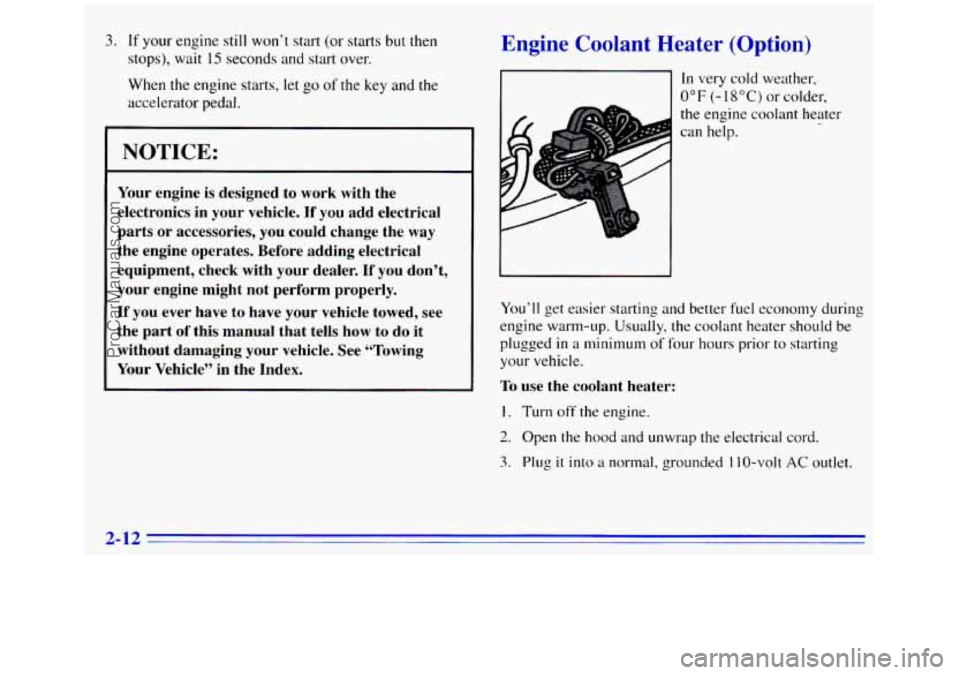
3. If your engine still won’t start (or starts but then
stops), wait
15 seconds and start over.
When the engine starts, let
go of the key and the
accelerator pedal.
I NOTICE:
Your engine is designed to work with the
electronics in your vehicle.
If you add electrical
parts or accessories,
you could change the way
the engine operates. Before adding electrical
equipment, check with your dealer.
If you don’t,
your engine might not perform properly.
If you ever have to have your vehicle towed, see
the part
of this manual that tells how to do it
without damaging your vehicle. See “Towing
Your Vehicle” in the Index.
Engine Coolant Heater (Option)
-
In very cold weather,
0°F (-18°C) or colder,
the engine coolant heater
can help.
You’ll get easier starting and better fuel economy during
engine warm-up. Usually, the coolant heater
should be
pl~~gged in a minimum of four hours prior to starting
your vehicle.
To use the coolant heater:
1. Turn off the engine.
2. Open the hood and unwrap the electrical cord.
3. Plug it into a normal, grounded 110-volt AC outlet.
2-12
ProCarManuals.com
Page 113 of 404

Your vehicle includes a number of storage
compartments for storage
of often used items.
Some vehicles have storage areas
in the instrument
panel. Use these spaces for items such
as gloves or
small books.
Some models
have a storage pocket on each of the
front doors.
Some vehicles have a storage area behind the seat.
Armrest Storage Compartment
Your vehicle may have a center armrest storage
compartment
in the front bench seat.
To open it, fold down the armrest, press the latch handle
located at
the front of the armrest. Then, let the lid pop
up and swing open.
The storage compartment
has a cassettekompact disc
holder. The holder
will store up to five compact disc
cases and
up to six cassette tape cases.
The storage compartment
also has a folding writing
table
on top of the armrest lid.
To use the writing table, pull the latch at the rear of the
table and swing the writing table forward. Use it to hold
pads
of paper and a pen.
Underhood Storage Area
There is a storage compartment in the front driver's side
of the engine compartment. Lift the cover to access the
storage area.
2-5 1
ProCarManuals.com
Page 135 of 404

Ventilation Tips
Your vehicle has air outlets in the center and on the sides
of your instrument panel. You can move the outlets from
side to side or up and down to direct the
flow of air, or
close the outlets altogether. When
you close an outlet, it
will increase the flow of air coming out of any outlets
that are open. These outlets do not completely
shut off
airflow when
in the closed position.
0
0
0
Keep the hood and front air inlet free of ice, snow or
any other obstruction (such
as leaves). The heater
and defroster
will work far better, reducing the
chance of fogging the inside
of your windows.
When you enter
a vehicle in cold weather, turn the
blower fan to HI for a few moments before driving.
This helps clear the intake ducts
of snow and
moisture, and reduces the chance
of fogging the
inside
of your windows.
Keep the air path under the front seats clear
of
objects. This helps air to circulate throughout
your vehicle.
Defogging and Defrosting
On cool, humid days, use DEFOG to keep the
windshield and side windows clear.
Use DEFROST
to remove fog or ice from the windshield in extremely
humid or cold conditions. Use DEFROST
with the
temperature knob toward
the red area and the fan control
toward
HI.
ProCarManuals.com
Page 219 of 404
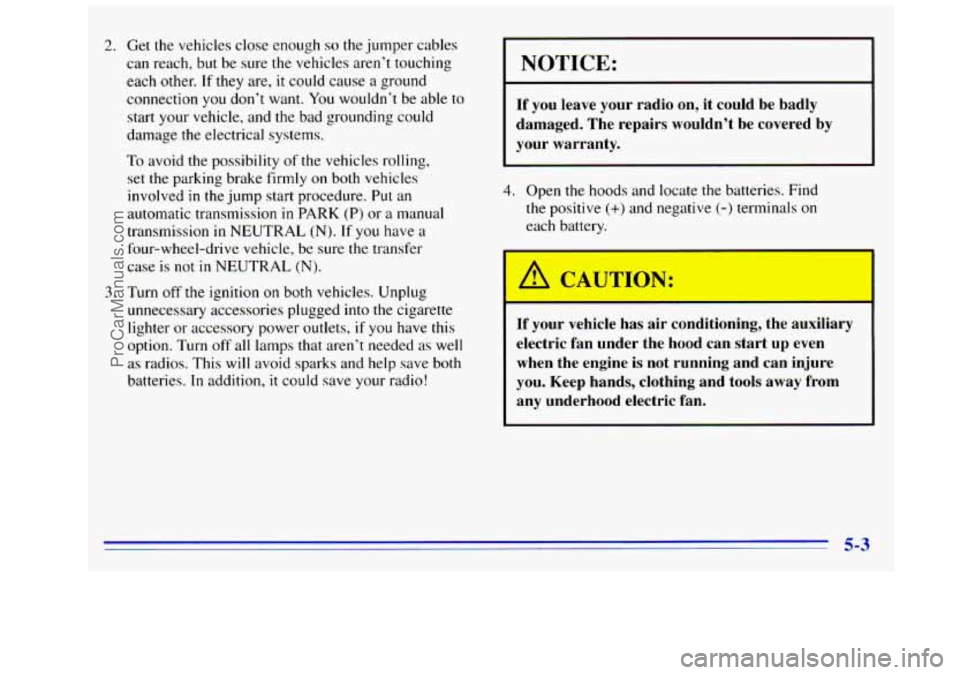
2. Get the vehicles close enough so the jumper cables
can reach, but be sure the ve.hicles aren’t touching
each other.
If they are, it could cause a ground
connection you don’t want. You wouldn’t be able to
start
your vehicle, and the bad grounding could
damage the electrical systems.
To avoid the possibility
of the vehicles rolling,
set the parking brake firmly on both vehicles
involved
in the jump start procedure. Put an
automatic transmission
in PARK (P) or a manual
transmission
in NEUTRAL (N). If you have a
four-wheel-drive vehicle, be sure the transfer
case is not in NEUTRAL
(N).
3. Turn off the ignition on both vehicles. Unplug
unnecessary accessories plugged into the cigarette
lighter or accessory power outlets,
if you have this
option. Turn
off all lamps that aren’t needed as well
as radios. This will avoid sparks and help save both
batteries.
In addition, it could save your radio!
NOTICE:
I
~~~ ~
If you leave your radio on, it could be badly
damaged. The repairs wouldn’t be covered by
your warranty.
4. Open the hoods and locate the batteries. Find
the positive
(+) and negative (-) terminals 011
each battery.
A CAUTION:
If your vehicle has air conditioning, the auxiliary
electric fan under the hood can start up even
when the engine
is not running and can injure
you. Keep hands, clothing and tools
away from
any underhood electric fan.
5-3
ProCarManuals.com
Page 226 of 404
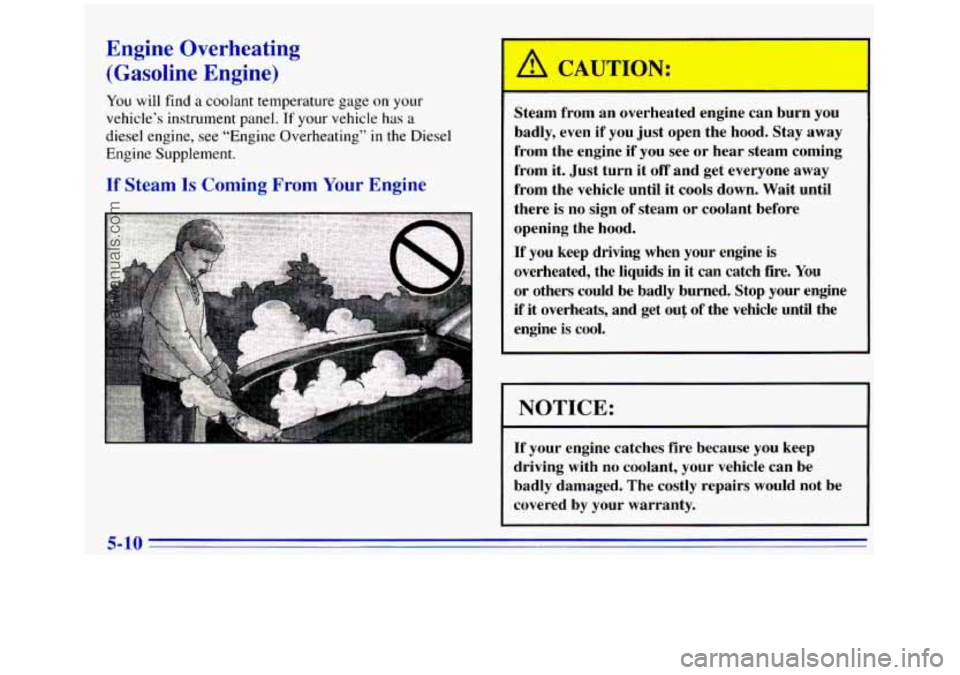
Engine Overheating
(Gasoline Engine)
You will find a coolant temperature gage on your
vehicle’s instrument panel.
If your vehicle has a
diesel engine, see “Engine Overheating” in the Diesel
Engine Supplement.
If Steam Is Coming From Your Engine
A CAUTION:
Steam from an overheated engine can burn you
badly, even if you just open the hood. Stay away
from the engine if you see
or hear steam coming
from it. Just turn it
off and get everyone away
from the vehicle until it cools down. Wait until
there is no sign
of steam or coolant before
opening the hood.
If you keep driving when your engine is
overheated, the liquids in it can catch
fire. You
or others could be badly burned. Stop your engine
if it overheats, and get out of the vehicle until the
engine is cool.
NOTICE:
If your engine catches fire because you keep
driving with no coolant, your vehicle can be
badly damaged. The costly repairs would not be
covered by your warranty.
5-10
ProCarManuals.com
Page 227 of 404
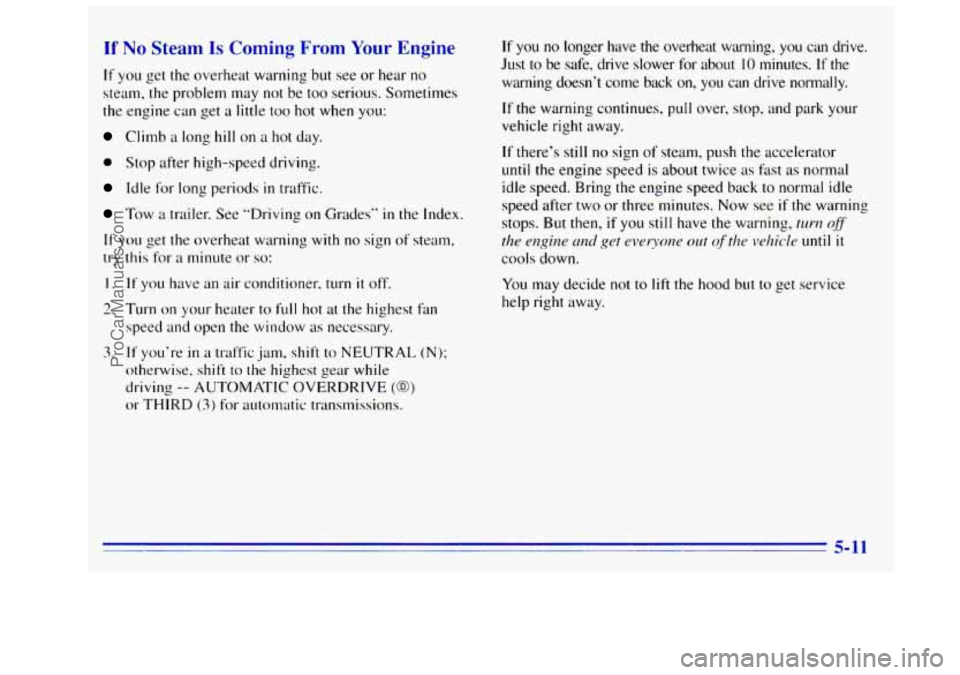
If No Steam Is Coming From Your Engine
If you get the overheat warning but see or hear no
steam, the problem may
not be too serious. Sometimes
the engine can get
a little too hot when you:
Climb a long hill on a hot day.
0 Stop after high-speed driving.
Idle for long periods in traffic.
Tow a trailer. See “Driving on Grades” in the Index.
If you get the overheat warning with no sign of steam,
try
this for a minute or so:
I. If you have an air conditioner, turn it off.
2. Turn on your heater to full hot at the highest fan
speed and open the window
as necessary.
3. If you’re in a traffic jam, shift to NEUTRAL (N);
otherwise, shift to the highest gear while
driving
-- AUTOMATIC OVERDRIVE (0)
or THIRD (3) for automatic transmissions.
If you no longer have the overheat warning, you can drive.
Just to be safe, drive slower
for about 10 minutes. If the
warning doesn’t come back
on, you can drive normally.
If the warning continues, pull over, stop, and park your
vehicle right away.
If there’s still
no sign of steam, push the accelerator
until the engine speed is about twice as fast as normal
idle speed. Bring the engine speed back
to normal idle
speed after two or three minutes. Now see
if the warning
stops.
But then, if you still have the warning, turn of
the engine nrzd get everyone nut of the vehicle until it
cools down.
You
may decide not to lift the hood but to get service
help right away.
5-11
ProCarManuals.com
Page 257 of 404

Hood Release
To open the hood, first pull
the handle inside the vehicle.
Then
go to the front of the vehicle and pull up on the
secondary hood release, located just
to the passenger
side
of the center of the grill.
Lift the
l~ood.
Before closing the hood, be sure all filler caps are on
properly.
Pull down the hood and close it firmly.
6-7
ProCarManuals.com
Page 369 of 404
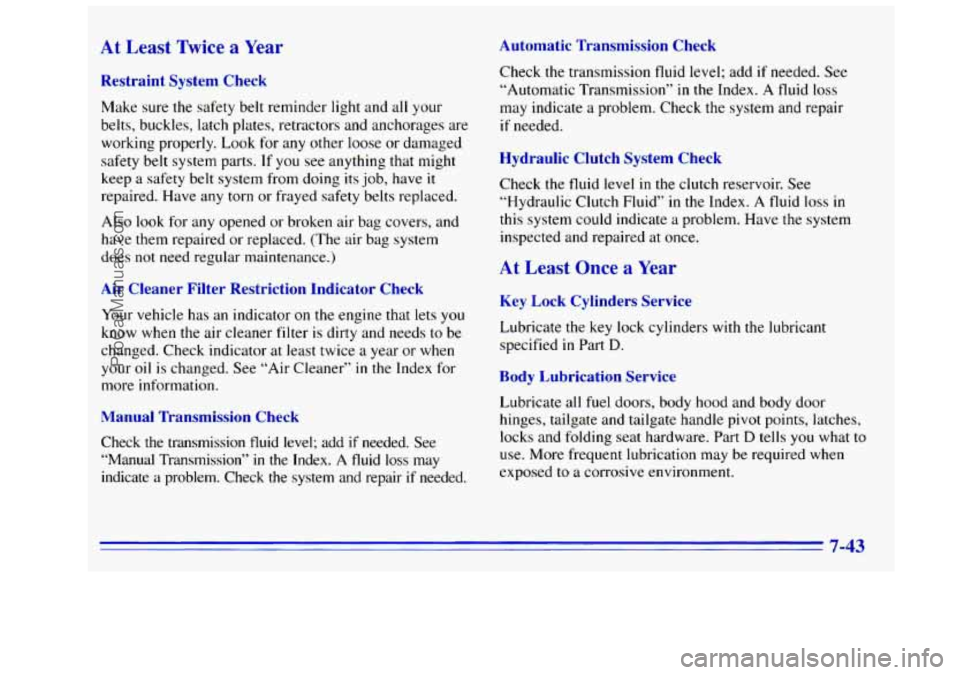
Automatic Transmission Check
Restraint System Check
Make sure the safety belt reminder light and all your
belts, buckles, latch plates, retractors and anchorages are
working properly. Look
for any other loose or damaged
safety belt system parts.
If you see anything that might
keep a safety belt system from doing its job, have
it
repaired. Have any torn or frayed safety belts replaced.
Also
look for any opened or broken air bag covers, and
have them repaired or replaced. (The air bag
system
does not need regular maintenance.)
Air Cleaner Filter Restriction Indicator Check
Your vehicle has an indicator on the engine that lets you
know when the air cleaner filter is dirty and needs to be
changed. Check indicator at least twice
a year or when
your
oil is changed. See “Air Cleaner” in the Index for
more information.
Manual Transmission Check
Check the transmission fluid level; add if needed. See
“Manual Transmission” in
the Index. A fluid loss may
indicate
a problem. Check the system and repair if needed. Check the transmission
fluid level; add if needed. See
“Automatic Transmission”
in the Index. A fluid loss
may indicate a problem. Check the system and repair
if needed.
Hydraulic Clutch System Check
Check the fluid level in the clutch reservoir. See
“Hydraulic Clutch Fluid”
in the Index. A fluid loss in
this system could indicate a problem. Have the system
inspected and repaired
at once.
At Least Once a Year
Key Lock Cylinders Service
Lubricate the key lock cylinders with the lubricant
specified
in Part D.
Body Lubrication Service
Lubricate all fuel doors, body hood and body door
hinges, tailgate and tailgate handle pivot points, latches,
locks and folding seat hardware. Part
D tells you what to
use. More frequent lubrication may be required when
exposed to a corrosive environment.
ProCarManuals.com